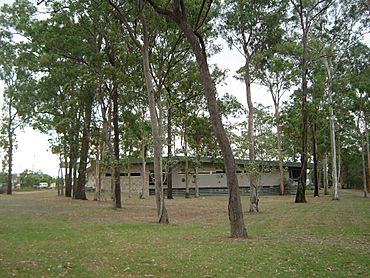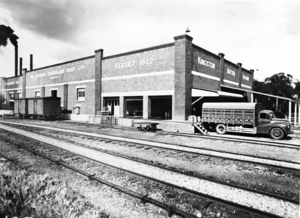Kingston, Queensland facts for kids
Quick facts for kids KingstonLogan City, Queensland |
|||||||||||||||
|---|---|---|---|---|---|---|---|---|---|---|---|---|---|---|---|

Marsden library is located in the far south of the suburb
|
|||||||||||||||
| Population | 10,539 (2016 census) | ||||||||||||||
| • Density | 1,573/km2 (4,070/sq mi) | ||||||||||||||
| Postcode(s) | 4114 | ||||||||||||||
| Area | 6.7 km2 (2.6 sq mi) | ||||||||||||||
| Time zone | AEST (UTC+10:00) | ||||||||||||||
| Location |
|
||||||||||||||
| LGA(s) | Logan City | ||||||||||||||
| State electorate(s) |
|
||||||||||||||
| Federal Division(s) | Rankin | ||||||||||||||
|
|||||||||||||||
Kingston is a town and suburb in the City of Logan, Queensland, Australia. In the 2016 census, Kingston had a population of 10,539 people.
Contents
Demographics
According to the 2016 census of Population, there were 10,539 people in Kingston.
- Aboriginal and Torres Strait Islander people made up 5.9% of the population.
- 55.4% of people were born in Australia. The next most common countries of birth were New Zealand 9.2%, Samoa 2.1%, England 2.1%, Myanmar 1.7% and Afghanistan 1.4%.
- 64.0% of people spoke only English at home. Other languages spoken at home included Samoan 4.1%, Karen 2.2%, Hindi 1.2%, Hazaraghi 1.1% and Arabic 1.1%.
- The most common responses for religion were No Religion 25.4% and Catholic 14.3%.
- The median age of the Kingston population was 31 years, 7 years below the national median of 38.
Transport
Kingston railway station provides access to regular Queensland Rail City network services to Brisbane and Beenleigh. The Logan Motorway passes through the south of Kingston but has no entrance or exit points to the suburb.
History
Like a number of other Logan City suburbs Kingston was once part of the Shire of Tingalpa. Dairying grew in importance in the area from the 1890s and in 1906 a meeting was held in Beenleigh to form a co-operative butter factory locally. The Southern Queensland Co-operative Dairy Company opened its factory in Kingston in June 1907. A piggery was established nearby in 1926 and pigs were fed on the buttermilk from the factory. The Kingston Butter Factory was enlarged in 1932 and operated successfully until after the war, when the dairying industry was being rationalised by the government. Peters bought the factory in 1958 and it ceased production in 1983. It now operates as a community arts centre and houses a theatre, arts and crafts stall and museum. The Kingston Butter Factory is on the Logan City Council Local Heritage Register for its historical, social and technological significance.
Kingston Gold Mine
The other major industrial activity of the area was the Kingston gold mine at Mount Taylor. Although gold was discovered in 1885, a geological survey was not undertaken until 1913 and underground mining began. In 1932, the Kingston Gold Mining Company began an open cut operation and mining continued until 1954. The area became an unofficial waste dump. It was eventually backfilled and subdivided into a housing estate in the late 1960s. (page57)
Kingston Industrial Waste Incident
In a tale startlingly similar to the Love Canal Disaster, the Kingston toxic waste story began in 1931 when cyanide and other toxins such as acid waste used in the Mount Taylor gold refining process were disposed of around the mine site. When the mine closed in 1954, the Albert Shire Council started to allow used recycled oil processing wastes to be dumped into a sludge pit on the site; this practice continued until 1967. From 1968 to 1973 the main open-cut pit was used as a domestic and industrial waste tip. In 1968 the council required the sludge pit to be filled as a condition of the land being divided for a residential subdivision. Workers simply moved the displaced sludge and re-dumped it into the open-cut pit.
In 1982, after the Logan Council took over the area, it discovered high levels of acid in the soil.
In September 1986 residents, in the Diamond street area of Kingston, started to notice black sludge beginning to ooze from the ground and seep into their gardens and began to complain of health problems to the Logan Council. (p4) By April 1987 the council was warning people to avoid the sludge. Surrounding soils and ground-water were also found to be contaminated.
In May 1987, frustrated with the council inaction, the residents of Kingston formed an organisation called RATS (Residents Against Toxic Substances). Because of increased leukaemia and other diseases in Kingston, they condemned the council and demanded action. Kingston residents could not afford a costly civil action so they went to the media and began a self-funded civic action.
It took four years of fighting the council and local governments for the residents of Kingston to be vindicated when the Minister for Emergency Services, Terry Mackenroth, ordered a review of all scientific and medical evidence, offered full health tests for residents and announced the Wayne Goss government would rehabilitate the site and pay for families to be moved away.
Eventually the state government resumed 46 properties and rehabilitated the area completing 1991, which is known as Kingston Park. (p4) The people of Kingston were moved on, Mount Taylor was sealed and landscaped, but no compensation came for residents reported illnesses and deaths (Some place the figure at six deaths due to leukemia). The final medical report found no evidence of "a major toxic hazard" in Kingston but recognised the "stress on a number of residents because of the uncertainty". Kingston residents finally could not prove that dumped toxic chemicals caused leukaemia or any other disease.
The total cost of this operation to date, including relocating infrastructure, the engineering required to seal the site and ongoing monitoring, is approximately $8 million. (pg6)
Although the Mount Taylor site was capped, sealed and vented in 1991, no toxic waste was removed. Some former residents believe there is still a toxic hazard risk in the future as a result.
Heritage listings
Kingston has a number of heritage-listed sites, including:
- Bega Road: Kingston Pioneer Cemetery
- 36 Mawarra Street: Mayes Cottage
- A brief history of Logan [1]
- A history of Mining in Logan [2]
- Pictures of the Kingston mine circa 1960s [3]
Education
Kingston State School is a government primary (Prep-6) school for boys and girls at 50 Juers Street (27°39′34″S 153°06′41″E / 27.6594°S 153.1115°E). In 2017, the school had an enrolment of 620 students with 48 teachers (44 full-time equivalent) and 34 non-teaching staff (22 full-time equivalent). It includes a special education program.
Groves Christian College is a private primary and secondary (Prep-12) school for boys and girls at 70 Laughlin Street (27°39′39″S 153°06′36″E / 27.6609°S 153.1099°E). It has its Maryfield primary (4-6) campus at Velorum Drive (27°39′37″S 153°05′56″E / 27.6604°S 153.0988°E). In 2017, the school had an enrolment of 1,391 students with 103 teachers (89 full-time equivalent) and 63 non-teaching staff (56 full-time equivalent).
Kingston State College is a government secondary (7-12) school for boys and girls at 62-84 Bega Road (27°39′51″S 153°06′44″E / 27.6641°S 153.1121°E). In 2017, the school had an enrolment of 876 students with 94 teachers (82 full-time equivalent) and 45 non-teaching staff (34 full-time equivalent). It includes a special education program.
The Centre Education Programme is a Catholic secondary (7-12) school for boys and girls at 108 Mudgee Street (27°40′04″S 153°06′37″E / 27.6679°S 153.1103°E). In 2017, the school had an enrolment of 118 students with 15 teachers (10 full-time equivalent) and 14 non-teaching staff (9 full-time equivalent).
YMCA Vocational School is a private secondary (7-10) facility of YMCA Vocational School at 41-45 Mary Street for boys and girls at 53 Mary Street (27°39′26″S 153°07′21″E / 27.6571°S 153.1225°E). In 2017, the school had an enrolment of 327 students with 21 teachers (19 full-time equivalent) and 35 non-teaching staff.
Kingston Centre for Continuing Secondary Education is a secondary (9-12) Centre for Continuing Secondary Education at 62-84 Bega Road (27°39′51″S 153°06′44″E / 27.6641°S 153.1121°E).



